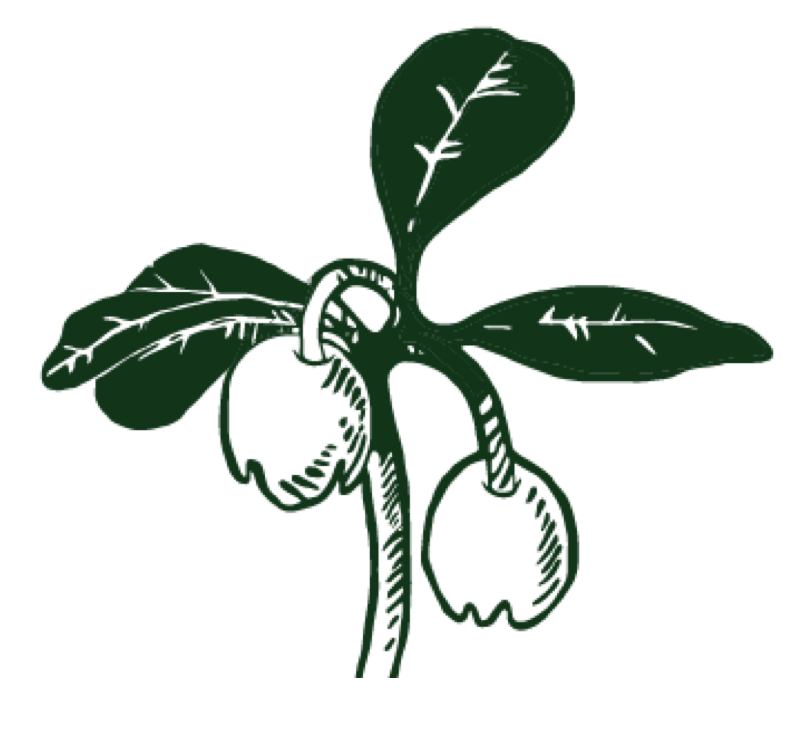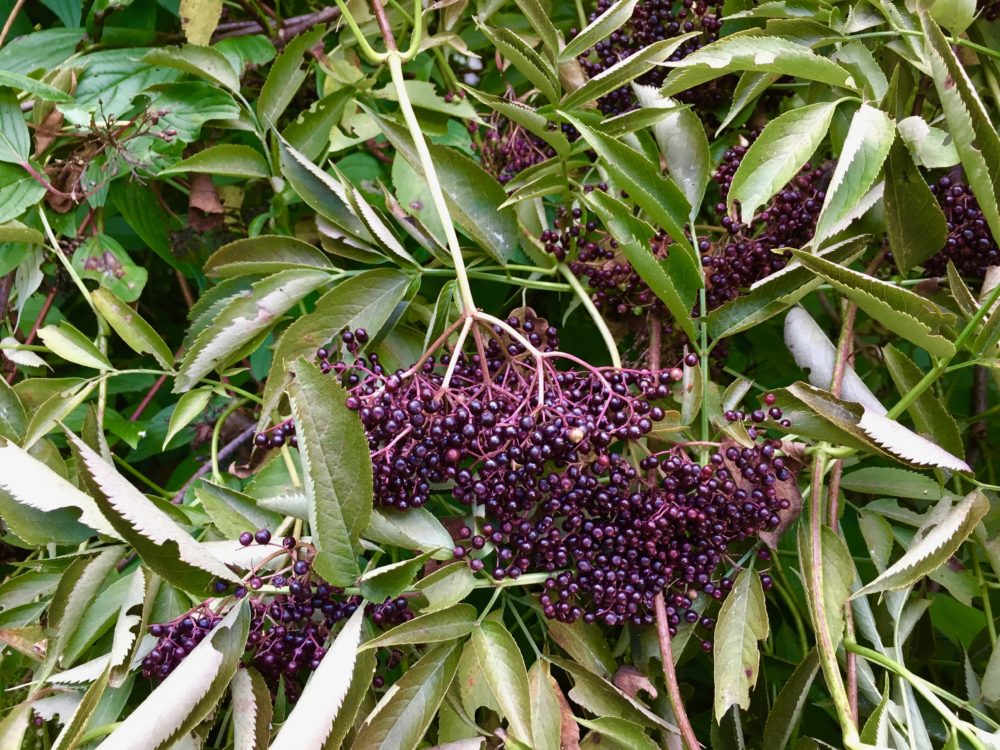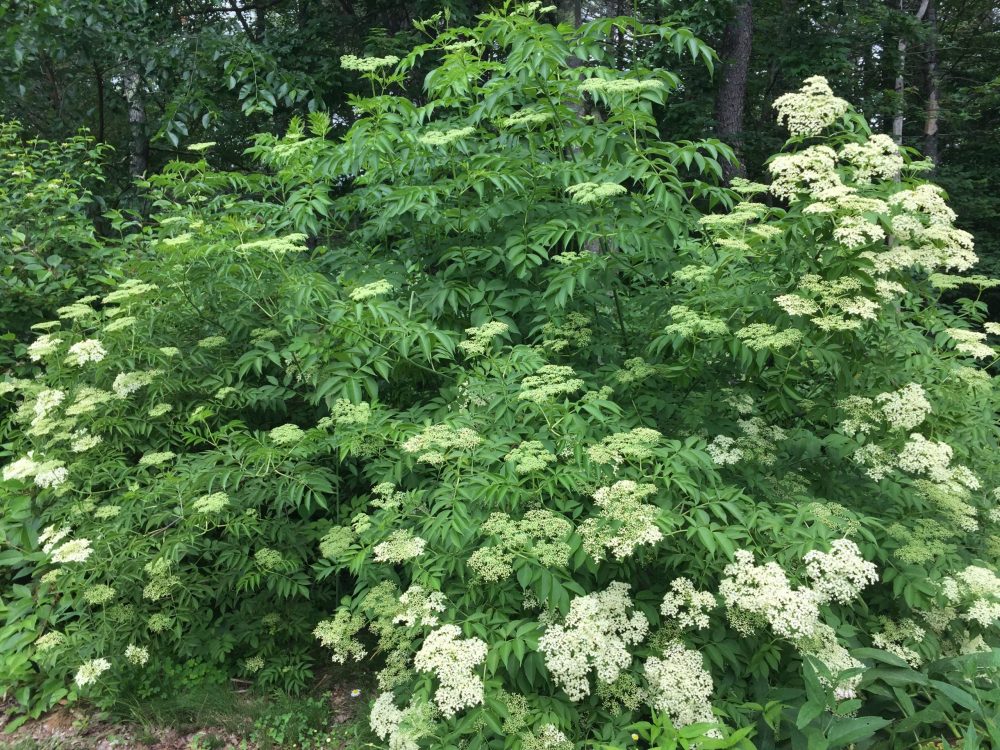Elder is one of my immune system staples and a favorite amongst my students and clients as well. Several studies support its ability to reduce the severity and duration of colds and flu, so with recent coronavirus and COVID-19 concerns, it has also gotten. caught up in the limelight. But, many herbalists warn that it could be dangerous in COVID-19. In this monograph on the elder plant and its. uses in immune health, I dig into the how, why, and my own perspective on this controversy...
Black Elder
(Sambucus nigra)
Commonly cultivated and grows wild throughout Europe. I’ll call this one “European elder” for easy differentiation from the American wild subspecies.
Similarly used ~ other blue/black elders, formerly considered separate species, now considered subspecies of nigra
- American Black Elder (S. nigra ssp. canadensis, formerly S. canadensis)
Common in the wild in Northeast and across the US east of the Rockies - Blue Elder (S. nigra ssp. cerulea, formerly S. caerulea, S. cerulea and S. mexicana)
- Chinese Elder (S. javanic, formerly S. formosana)
Probably also Dwarf Elder (S. ebulus)
Generally NOT Red Elder (S. racemosa), which is more nauseating and toxic internally
Parts Used
- Berry: dried or cooked, internally (mainly to limit viral replication, as a pigment-rich antioxidant)
- Flower: dried or cooked, internally (mainly as an antihistamine, diaphoretic, to vent/clear heat)
Note that fresh berries and possibly flowers are incredibly nauseating and may be moderately toxic. Some people react more strongly to the nauseating properties though most people do not have an issue with the dried or cooked berries and flowers.
Less Commonly Used Parts
- Leaf (mainly topically for aches, pains, sprains, bruises, like comfrey or arnica
- Root, Bark, Stem?
These parts are more nauseating and are traditionally regarded toxic/more toxic, especially fresh, tough Stephen Buhner feels differently and that dried plant decoctions are useful and more medicinal. I personally go with conventional wisdom and do not use these parts internally. Michael Moore warned that American species have higher levels of the potentially toxic, nauseating constituents compared to European elder.
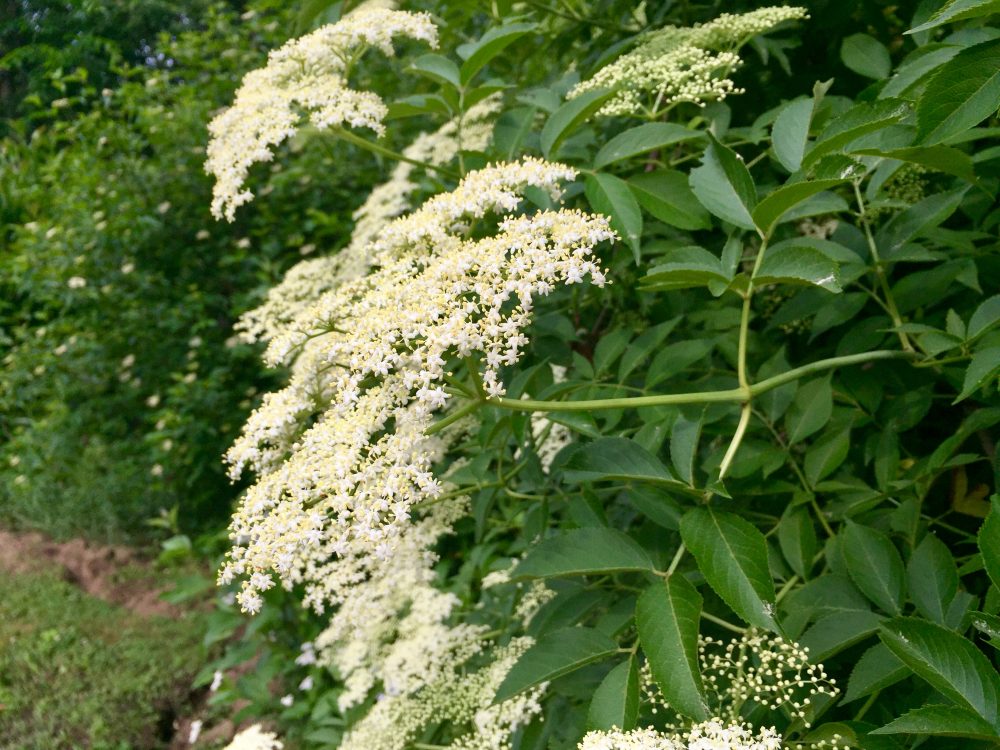
Identifying Black and American Black Elder
Elder is somewhat unique in having all of the following characteristics:
- Robust shrub, sometimes a small, shrubby tree. The woody parts persist through winter; leaves drop, but the plant itself does not die back in winter.
- Particularly prefers damp, rich soil in the edge of sun and shade – drainage ditches lining ponds, streams, lakes, rivers, edges of forests and yards. It can grow in drier locations.
- Flat-topped cluster of tiny 5-petaled cream/white flowers complex, irregular, branching compound cyme inflorescence (not an umbel inflorescence that would suggest ginseng or parsley family; not a spike-like raceme, suggesting red elder)
- Leaf arrangement on the main stem, arrangement of branches is opposite (parsley family may look similar but is alternating)
- Each leaf is composed of compound leaflets (some, like Newcomb’s Wildflower Guide, would call this a “divided” leaf). Leaves have stalks. The leaf/leaflet edges are toothed. Leaves are deciduous/fall off in winter. (Note that plants like water hemlock in the parsley family that look similar have opposite leaflets but the main leaves themselves are alternating.) American elder tends to have 5-11 leaflets per leaf whereas European elder usually has 3-7 leaflets per leaf.
- Older stems tend to be pale grey-brown with distinct, raised lighter splotches called lenticels. There are no spines, thorns, or prickles (which could indicate other plants like Aralia hispida, which looks similar but is smaller, with alternate leaves.)
- Unripe berries are green, then ripen to purple/blue/black berries in late summer or autumn (as opposed to parsley family plants that put out seeds, and red elder which produces vibrant red berries mid-summer). Berries are small. Flower stems may turn purple as berries ripen, but not always.
Energetics
cooling, drying
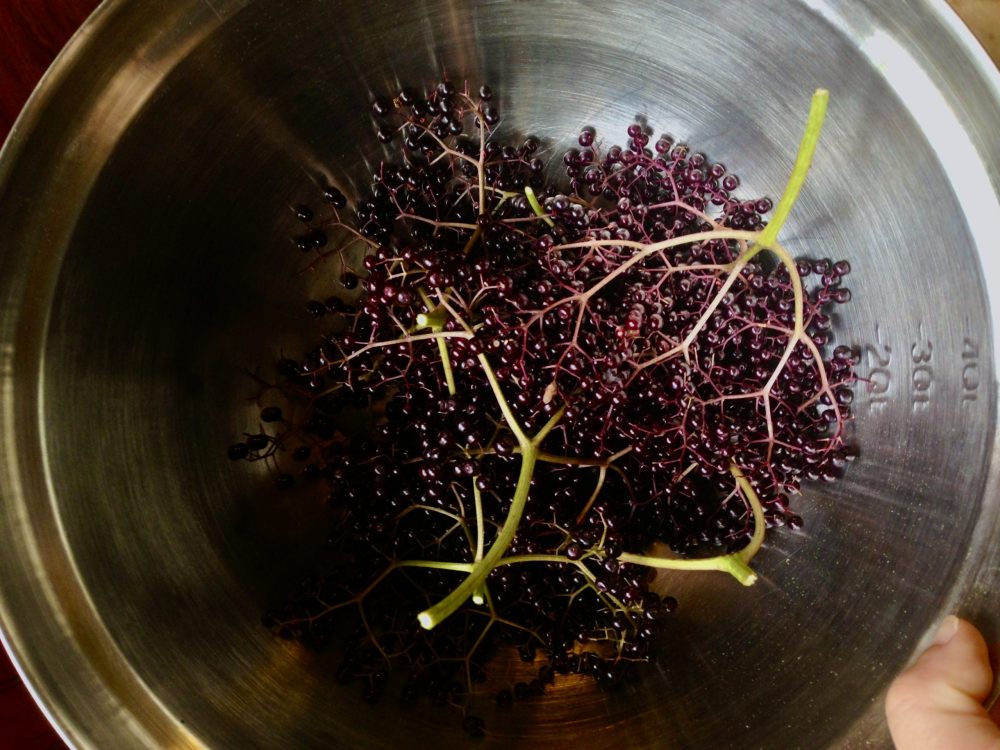
Medicinal Uses
ElderBERRY to Support Resistance to Infections
I like to think of elderberries as a force field of protection when it comes to viral infections like the cold and flu (it may also help in early exposure to COVID-19, but we don’t have data to support it). While elderberry could generally safely be used daily as a preventatively and in acute illness, it’s really most appropriate when you’re susceptible, likely to be exposed to germs, and/or at the very first sign of infection. In these times it may avert an infection, or more likely, reduce the severity and speed up the recovery time.
Primarily from lab studies (which may or may not indicate what's really happening in the human body when you ingest the herbs), we get some idea of how elderberry could be working. The prevailing belief is that elderberry blocks viruses from entering cells and limits their ability to replicate and spread by interacting directly with the virus’ envelope and inhibiting its enzyme neuraminidase. This seems to lead to a less virulent infection and better, faster resolution, which coincides with clinical symptom. data. Flavonoid pigment-based anthocyanins cyanidin 3-glycoside and cyanidin 3-sambubioside appear to provide these anti-inflammatory, anti-viral activities. Higher and more regular doses provide better results.[1][2] Standardized elderberry liquid extract has also been shown to have antibacterial activity against both Gram-positive bacteria of Streptococcus pyogenes and group C and G Streptococci, and the Gram-negative bacterium Branhamella catarrhalis in liquid cultures.[3]
Some herbalists refer to elder as an immune stimulant or immune modulator. Although there may be some validity to this in cancer care (for which the research is almost entirely based on highly preliminary lab tests), and a hint of it in some of the anti-viral lab tests, I personally don’t consider elder to fit significantly into either of these categories. The activity appears to be primarily from the interaction of elder with viral cells, not via direct immune system activity. That said, a lot more human research is needed to fully understand elder’s exact actions in the body.
Elderberries have traditionally been used for coughs and respiratory conditions, usually in syrup form. However, much of the traditional medicinal use of elder revolves around the flowers (discussed further down), with the berries more often finding their way into pie, wine, and other foods as well as clothing dye.[4] Various studies have also explored elderberry’s use against cancer cells (primarily via lectin compounds), cardiometabolic health (primarily via pigments, as with many other blue-purple berries), etc.[5] It should be noted that all of the below clinical trials were funded by the companies making the elderberry products.
Clinical Trial Highlights
For the record these are the only major human clinical trials on elderberry, and all of them were funded by companies that sell elderberry. I'm not saying the results aren't valid - they do show simialr results and match what I personally see in myself, my family, my practice, and my students - but we still need to recognize the limitations. It would be great to have more (unbiased) human clinical trials.
R = Randomized; DB = Double-Blind; PC = Placebo Controlled; C = Controlled (not by placebo)
- Reduced Symptoms, Shorter Duration of Influenza B: DBPC study elder shortened the duration of the flu. In 40 people living in an agriculture community kibbutz in an outbreak of influenza B/Panama in 1993. “A significant improvement of the symptoms, including fever, was seen in 93.3% of the cases in the SAM-treated group within 2 days, whereas in the control group 91.7% of the patients showed an improvement within 6 days… A complete cure was achieved within 2 to 3 days in nearly 90% of the SAM-treated group and within at least 6 days in the placebo group.” Children received 2 tablespoons and adults 4 tablespoons of Sambucol elderberry syrup or placebo daily f or 3 days. Sambucol is typically Made with elderberry juice, raspberry extract, glucose, citric acid, and honey.
- Lab studies also conducted as part of this study showed benefits for various strains including influenza A, B, and H1N1. PMID: 9395631 Abstract and Full Text[6]
- Reduced Symptoms, Shorter Duration of Influenza A and B Infections: RDBPC. Study of 60 adults suffering from flu-like symptoms for 48 hours or less during flu season in Norway were given 15 ml Sambucol elderberry or placebo syrup four times a day for 5 days. “Symptoms were relieved on average 4 days earlier and use of rescue medication was significantly less in those receiving elderberry extract compared with placebo.” Symptoms that improved more quickly included aches and pains, cough frequency, quality of sleep, mucus discharge, and nasal congestion. Improvements began to occur in the elder group on day two, and the elder group also did not opt to use OTC remedies like nasal spray and pain relievers as often as the placebo group. PMID: 15080016 Abstract and Full Text[7]
- Reduced Symptoms, Shorter Duration of Colds in Air Travelers: RDBPC study of 312 “long haul” international economy air travelers traveling from Australia. The placebo group has a non-significant increased number of cold episodes and a significantly longer duration of cold episode days as well as higher symptom scores. The elderberry group took black elderberry capsules containing 300 mg elderberry extract (22% polyphenols including quercetin and rutin, 15% anthyocyanodins) sold by Berry Pharma in Italy. Participants took 2 capsules per day from one day before leaving home then 3 capsules per day until 4-5 days after arriving in their destination. PMID: 27023596 PMCID: PMC4848651 Abstract and Full Text[8]
- We have no data available to tell us whether elderberry would have similar effects to reduce the severity and duration of COVID-19, but a few highly preliminary test tube studies on other species/strains of coronavirus do show these benefits. We hope so since other/previous coronaviruses are moderately common and present like a cold. In lab studies, extracts from black and Chinese elderberries did indeed prevent other types of coronaviruses from attaching to cells.[9] A study on infectious bronchitis virus (a pathogenic chicken coronavirus) concluded, “These results demonstrate that nigra extract can inhibit IBV at an early point in infection, probably by rendering the virus non-infectious.”[10] But, real life human studies on COVID-19 specifically would be nice.
Examples of times I like to use elderberry:
- When traveling, especially by plane
- When around others who are sick – I often take it when visiting friends’ families and attending parties because I easily catch colds from others, especially children
- When I am run down, am short on sleep, or didn’t sleep well (which for me greatly increases my likelihood of getting sick), especially if I’m also going to be around other people and their germs. Several studies link just one night of sleep deprivation to a three times greater risk of getting sick when exposed to the common cold.
- At the first signs of feeling unwell – for me this is usually sore throat, nausea, and/or achy fatigue – I take it frequently throughout the day
When elderberry is LESS appropriate:
- If the goal is to strengthen and improve your immune system response – especially in the day-to-day prevention of common infection – elderberry is not the most ideal herb (though it’s not likely to harm and may work to some extent). Long-term immune tonics like medicinal mushrooms (reishi and shiitake are faves) and astragalus as well as immune-supportive adaptogens like holy basil, ashwagandha, codonopsis, and schizandra are better here. These all have different indications, so get to know the plants to decide which one(s) are most appropriate for you.
- In acute infection elderberry probably won’t hurt, but it’s also less likely to be effective. Why put up a force field if you’ve already been infiltrated? Herbs targeted to the symptoms as well as lymphatics are likely more appropriate here. In my personal and clinical experience, I don't see elderberry doing much at this stage of illness.
- If you’re one of the unlucky people who gets super nauseous from elderberry or flower in any form at any dose, then other immune herbs are better options for you.
- For most people with autoimmune disease, elder is fine and does not exacerbate a flare. However, in rare cases this could occur. Listen to your body and opt for a different herb if this applies to you.
- If you feel worse when you take elderberry or elder flower, then listen to your body and don’t take it again. This is very rare, but it can happen. Maybe due to direct immune action or simply because it's very nauseating for sensitive individuals.
Personally, when I take elderberry syrup at the first signs of infection, I notice an immediate backing down of symptoms within about 15 to 30 minutes, which lasts a few hours. If I don’t take another dose, I’ll feel the symptoms creep back. Others have reported similar results. I personally vastly prefer Darcey Blue’s recipe, which I make at home, which uses dried elderberries, elder flowers, ginger, and cinnamon infused in a combination of alcohol and hot water, strained, with honey and fresh lemon juice added (recipe in preparations and dose section). I do like the use of dried berries, made without excessive heat, well-strained of the potentially nauseating berry seeds, and the addition of the other useful ingredients. I personally do get very nauseous and feel flu-like with Sambucol but not the recipe I use and make.
Concerns About Elderberry, Cytokine Storm, Autoimmune Disease & Covid-19
Much has been floating around the herbal ethers, especially social media, warning people against taking elderberry due to potential concerns of up-regulating the immune system, causing cytokine storm, aggravating autoimmune disease flares, and possibly worsening the progression of COVID-19. Most of these articles are poorly written and backed (and even a bit hysterical).[11] One of the better written and annotated articles raising these concerns is by Stephany Riley Hoffelt[12] – while I don’t agree with her perspective, I think it’s always nice to look at alternate viewpoints, especially since there’s still much we don’t know. Herbalists who specialize in working with clients with autoimmune disorders range from having never seen an issue with elderberry aggravating flares (such as Rosalee de la Foret) to seeing it often cause problems (such as the “Barefoot Dragonfly”). While I don’t specialize in autoimmune disease, I personally have a mild autoimmune disease and many of my clients and students have autoimmune disease; and I have also never seen the elderberry syrup recipe I use and recommend cause a flare.
Personally, I think this is unlikely, overblown, and largely theoretical risk, but let’s back up and explore the origin more…
Concerns around elder and cytokine storm appear to come primarily from a small lab study on Sambucol for the flu. Here are the details of that study:
- Blood-derived monocytes were taken from 12 healthy human donors
- In a lab, these monocytes were incubated with different Sambucol preparations, and production of inflammatory cytokines: “IL-1 beta, TNF-alpha, IL-6, IL-8) was significantly increased, mostly by the Sambucol Black Elderberry Extract (2-45 fold).”
- The researchers theorized that this was a mechanism for efficacy for elderberry syrup and why it helped reduce symptoms and duration of the flu in other, aforementioned, clinical human studies.
That’s it. One lab study, which was coming from the perspective of this being a beneficial effect and not at all related to cytokine storm.
So, what are cytokines? These are messengers of the immune system that are often inflammatory by nature that amp up the immune response. Some inflammation is part of a healthy immune response to infection and part of the reason why taking anti-inflammatory drugs like NSAIDs and steroids ultimately worsen the risk of infection or the slow healing response. Some inflammatory cytokine activity during infection is good, healthy, and normal most of the time.
What about cytokine storm, autoimmune disease, and COVID-19? Cytokine storm is a very rare but serious life-threatening condition in which cytokine up-regulation becomes excessive and overwhelms the body. There is some evidence that later stages of serious COVID-19 and the 1918 flu infection involved cytokine storm. At this stage of illness, the situation is dire and a person would be in an ICU, not at home sipping elderberry syrup. There is no direct evidence that elder would be more likely to encourage cytokine state. We really have no idea whether elder would be a problem here or not in COVID-19, exacerbating disease and fatality risk, but many herbalists[13] are recommending against elder especially in acute infection to err on the side of caution. Herbs that reduce or modulate inflammatory cytokines such as Baikal skullcap root, Chinese forsythia flowers, and honeysuckle flowers may be more appropriate in acute cases (this is based on data coming from China - I personally do not have experience with these herbs even though I "hear a lot of good things," and they're moderately hard to find in commerce.) and acute cases will generally require immediate medical attention as well.
Is elderberry pro-inflammatory or anti-inflammatory? Probably both, and it may depend on the individual person and individual situation. Interestingly, another study on atherosclerosis (a totally different health topic even if the cytokines are the same) determined that the combination of elderberry, violet herb, and calendula flowers had anti-cytokine/anti-inflammatory activity.[14]
And remember, this elderberry info is just my take based on what little research we have and my personal experience - none of us have any idea how this will or won’t work for COVID-19 and its exact mechanisms of action, it’s all theoretical and based on just a few lab tests. (And we all know that what happens in a Petri dish dousing cells/cultures with herbs directly does not aways correlate to the complex human body when you ingest an herb.) It is by no means Gospel. 😉
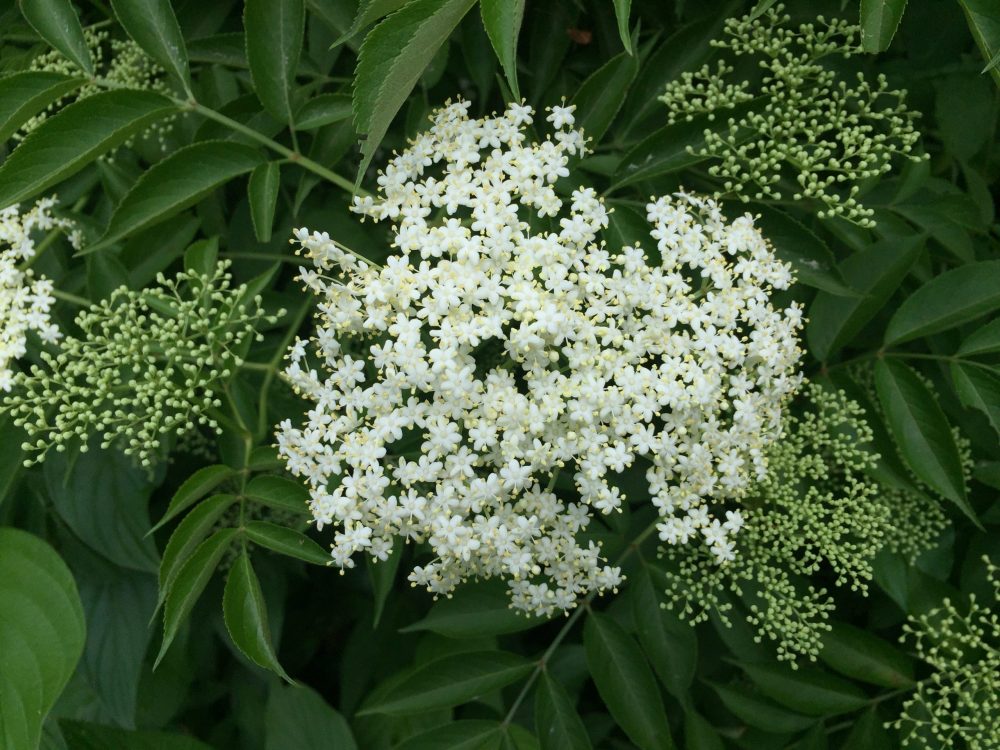
Elder FLOWER's Diverse and Often Overlooked Benefits
I personally use elderberry and elderflower in combination in my homemade elder syrup. Elder flowers offer a variety of supportive benefits. The German Commission E approved elder flower for colds, as a diaphoretic, and to increase bronchial secretions. Elder flower also has mild relaxing, anti-inflammatory, nervine (nervous-system calming/restorative), and mild diuretic and laxative properties.[15][16]
Diaphoretic: Elder flowers gently increase sweating (diaphoresis) to “vent heat” and assist the fever response in faster resolution of common viral and possibly bacterial infections. This is one of the better tasting and safer diaphoretic herbs, making it popular in children’s formulas as well. It’s particularly popular for dry fevers in children.[17] Other herbal diaphoretics include yarrow aerial parts, ginger root, boneset aerial parts, and peppermint. A tea made of elder flower, yarrow, and peppermint is a popular folk remedy for colds and the flu; Traditional Medicinal’s Gypsy Cold Care tea is based on this blend with additional ingredients. Michael Moore recommend caution using elder flower in children with a history of high fevers and convulsions because elder may raise fever slightly before lowering it.[18]
Anti-Histamine and Allergy Support: Elder flower helps tone the mucus membrane in the nose and throat and may offer antihistamine-like activity for seasonal allergies, colds, congestion, congestion-related earache, sinusitis, and upper respiratory infections both acutely and prophylactically. This is popular as a tea or dry flower tincture.[19]
Mildly Better Symptom Resolution in Acute Viral Rhinosinusitus: Over the course of 15 days, people taking a European dry herb extract blend of elder flower, sorrel, verbena, primula, and gentian in the ratio of 3:3:3:3:1 had moderately better symptom improvement compared to the placebo group.[20]
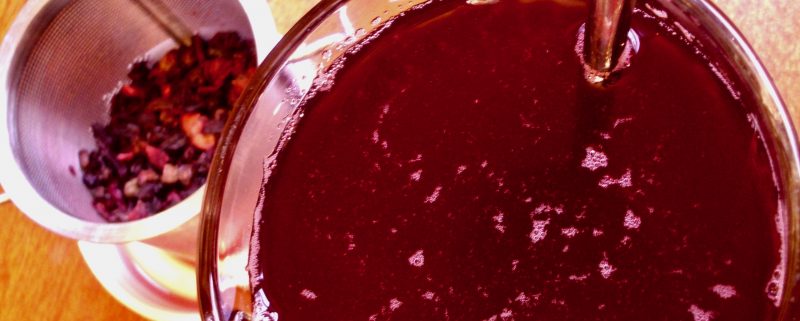
Growing, Harvesting, Wildcrafting, Preparation, and Dose
Cultivating Elder
This plant is pretty easy to grow from young sapling. It will grow slowly at first until it gets established, then explode with growth. Don’t be surprise if deer munch on it in the early years; consider protecting it, but don’t worry about that too much. It prefers full to part-sun and will produce better in sunnier locations. It prefers moist, rich soil and wet feet, but it can adapt to drier locations. It takes a few years for it to get established and begin producing prolific flowers and berries. Birds love to eat the berries, and if sometimes the berries drop before they fully ripen (this may be due to a lack of soil fertility).
Wildcrafting Elder
Watch for poison ivy and respect the habitats and wild forage this shrub provides for wildlife – leave plenty behind. Both the flowers and berries have a short season, so be attentive to catch them on the right day. Ideally, find a stand that you can “steward” and watch year to year to ensure that your harvest are not negatively impacting its production. Avoid harvesting from polluted areas such as roadsides or questionable watersheds or near locations that may be sprayed with chemicals (such as near train tracks, underneath power lines, or near conventional farms).
Harvesting & Processing
Harvest flowers when they are in peak bloom. Here in New Hampshire, this is typically late June. Plants located in sunny locations will have better-tasting/smelling and more prolific blooms. Trim flowering tops, dry thoroughly (preferably in a dehydrator), then pull the dried blossoms off the stems with a fork. It’s ok if a few small flower stems get through, but aim to have as little of this as possible without going insane.
Harvest berries in late summer/early autumn when they’re rip, deeply blue-black-purple, often drooping with weight. They’re at peak only for a short time, and birds quickly swoop in to get them. You may want to drape a bird net over your elder bush before it ripens. You can manually remove the berries from the stems on the bush into a bucket or cut off berry tops to process at home. Once again, a fork comes in handy to remove the berries, fresh or dry. Cook fresh or dry in a dehydrator for use.
Preparation & Dose
Tea (berry or flower): 1 teaspoon of dried flowers and/or berries per cup of hot water infused, 1-3 cups daily
Tincture (flower): Dried flowers 1:5 in 50-60 percent alcohol. 1-3 ml daily. Berries could be made and taken similarly, but I don’t care for berry tincture and find syrups more enjoyable and stable.
Syrup, Oxymel, or Glycerite (berry especially, also flower): ½ to 1 teaspoon taken daily, or every few hours at the onset of an infection
Here’s a link to my favorite elderberry syrup, tea, and oxymel recipes.
Jam, cooked juice, wine, and cordials are popular as well. I recommend straining seeds well from the final product though not everyone does.
I personally do not use the leaves for medicine internally, though Stephen Buhner does use the dried leaf decoction. I'm a cautious person and not comfortable with the nausea and toxicity potential. Buhner is an amazing researcher and I do respect his work, but it should be noted that he mainly. extrapolates from highly preliminary research (often lab studies done in Petri dishes), often without clinical experience, leading to recommendations for herbs that have little to no clinical evidence and are very hard to find in commerce. In the case of elder leaf, there is some historical evidence from the Eclectics for its use, but I am personally not comfortable using it.
Cautions
The raw elder plant (including berries) contains cyanogenic glycosides including sambunigrin that are hydrolyzed to hydrogen cyanide in the gastrointestinal tract. Poisoning and hospitalization occurred from individuals who drank raw berry juice made with wild Mexican blue elder (S. nigra ssp. cerulea, formerly S. mexicana)[21]. Smaller amounts may be tolerated or cause nausea, vomiting, and diarrhea. Cooking or drying the berries or flowers renders them completely safe. The fruit contains the lowest quantity of the cyanogenic glycosides, and quantities can vary based on growing conditions. Cooking is the most scientifically recognized method to eliminate the volatile cyanogenic glycosides,[22] though drying the berries and straining out the seeds from your final preparation may also reduce nausea and toxicity.[23][24] Unripe berries may be particularly problematic.[25] The roots, barks, and leaves are generally not recommended ingested in any form due to increased potential for toxicity, though a few herbalists disagree. Some people are more sensitive to the nauseating effects of elder in all its forms. Allergy is possible but rare.[26] The flowers are considered to be the safest part of elder, then the ripe berry flesh. Seeds can aggravate the gastrointestinal system, and unripe berries should be avoided.[27][28]
Michael Moore noted that the wild American elder species contain higher levels of the potentially toxic and nauseating sambusine. While he used the dried berries and flowers (and, less commonly, dried leaves) comfortably, he urged against the European tradition of elder bark and roots with our wild American species.[29] This variation among elder species (now taxonomically considered subspecies rather than distinct species) from Europe versus America may be why European herbalists are more dismissive of elder’s nausea and toxicity concerns compared to American herbalists.
Red elder is not recommended for ingestion and has been associated with the death of children using the stems to make blow guns.[30]
Resources:
- American Herbalists Guild COVID-19 Resource Page
- Rosalee de la Foret’s https://www.herbalremediesadvice.org/elderberry-benefits.html and she also covers it in her excellent book Alchemy of Herbs and also see her thoughts specifically on coronavirus/COVID-19 and cytokine storm at https://www.herbalremediesadvice.org/herbs-for-immunity.html
- Guido Mase’s excellent webinar with BotanicWise: COVID-19: An Herbalist’s Perspective, available to watch on Facebook here.
- Books by Matthew Wood, Andrew Chevallier, Sharol Tilgner, and Michael Moore, referenced in the annotated section
- *Sharol Tilgner, Elder Flowers, 1999: https://www.herbaltransitions.com/materiamedica/Sambucus.htm
- *Sambucus Monograph (Alternative Medicine Review), 2005: http://www.altmedrev.com/archive/publications/10/1/51.pdf
- A historical perspective in Maud Grieve’s Modern Herbal, first published in 1931 https://botanical.com/botanical/mgmh/e/elder-04.html
- King’s Dispensatory USP listing for Sambucus, 1898, on Henriette Kress’ site, which discusses use of the flowers and inner bark https://www.henriettes-herb.com/eclectic/kings/sambucus.html
- Also see the annotated studies
* These are handy resources, but it should be noted that the authors are associated with herbal products manufacturing.
Identification Resources
Since elder is a shrub, it is not listed in most plant ID guides. It won’t be in many wildlflower identification guides (most of which stick to plants that die back completely in winter). It also won’t be in many tree guides since it’s not usually big enough to be considered a tree. However, it is listed in Newcomb’s and Audubon wildflower guides, which include showy flowering shrubs.
- https://gobotany.nativeplanttrust.org/genus/sambucus/
- Peterson’s: A Field Guide to Trees and Shrubs (this is not very easy to use for identifying a plant cold, but it’s good to help discern species)
- Newcomb’s Wildflower Guide
- USDA Plant Guide for Common Elderberry https://plants.usda.gov/plantguide/pdf/cs_sanic4.pdf
Studies and Other Annotated Sources
[1] Summer 2017 Interfering With Lipid Raft Association: A Mechanism to Control Influenza Virus Infection By Sambucus Nigra. Shahla Shahsavandi, Mohammad Majid Ebrahimi, Ameneh Hasaninejad Farahani. Iran J Pharm Res, 16 (3), 1147-1154. PMID: 29201101 PMCID: PMC5610768 Abstract and Full Text
[2] Binding of a Natural Anthocyanin Inhibitor to Influenza Neuraminidase by Mass Spectrometry. Kavya Swaminathan, Jeffrey C Dyason, Andrea Maggioni, Mark von Itzstein, Kevin M Downard. Anal Bioanal Chem, 405 (20), 6563-72 Aug 2013 PMID: 23748498 Abstract and Full Text
[3] Inhibitory Activity of a Standardized Elderberry Liquid Extract Against Clinically-Relevant Human Respiratory Bacterial Pathogens and Influenza A and B Viruses. Christian Krawitz, Mobarak Abu Mraheil, Michael Stein, Can Imirzalioglu, Eugen Domann, Stephan Pleschka, Torsten Hain. BMC Complement Altern Med, 11, 16 2011 Feb 25. PMID: 21352539 PMCID: PMC3056848 Abstract and Full Text
[4] Kings Dispensatory and Maud Grieve’s Modern Herbal
[5] HerbMedPro via HerbalGram
[6] Inhibition of Several Strains of Influenza Virus in Vitro and Reduction of Symptoms by an Elderberry Extract (Sambucus Nigra L.) During an Outbreak of Influenza B Panama. Z Zakay-Rones 1 , N Varsano, M Zlotnik, O Manor, L Regev, M Schlesinger, M Mumcuoglu. J Altern Complement Med, 1 (4), 361-9 Winter 1995 PMID: 9395631 Abstract and Full Text
[7] J Int Med Res , 32 (2), 132-40 Mar-Apr 2004 Randomized Study of the Efficacy and Safety of Oral Elderberry Extract in the Treatment of Influenza A and B Virus Infections Z Zakay-Rones 1 , E Thom, T Wollan, J Wadstein PMID: 15080016 Abstract and Full Text
[8] Elderberry Supplementation Reduces Cold Duration and Symptoms in Air-Travellers: A Randomized, Double-Blind Placebo-Controlled Clinical Trial. Evelin Tiralongo, Shirley S Wee, Rodney A Lea. Nutrients, 8 (4), 182 2016 Mar 24. PMID: 27023596 PMCID: PMC4848651 Abstract and Full Text
[9] Antiviral Activity of Sambucus FormosanaNakai Ethanol Extract and Related Phenolic Acid Constituents Against Human Coronavirus NL63. Jing-Ru Weng, Chen-Sheng Lin, Hsueh-Chou Lai, Yu-Ping Lin, Ching-Ying Wang, Yu-Chi Tsai, Kun-Chang Wu, Su-Hua Huang, Cheng-Wen Lin. Virus Res, 273, 197767 Nov 2019. PMID: 31560964 Abstract and Full Text
[10] Sambucus Nigra Extracts Inhibit Infectious Bronchitis Virus at an Early Point During Replication. Christie Chen, David M Zuckerman, Susanna Brantley, Michka Sharpe, Kevin Childress, Egbert Hoiczyk, Amanda R Pendleton. BMC Vet Res, 10, 24 2014 Jan 16. PMID: 24433341 PMCID: PMC3899428 Abstract and Full Text
[11] https://survivalblog.com/letter-elderberry-wuhan/
[12] Stephany Riley Hoffelt, When Not to Use Elderberry: Using a Little Discernment https://naturallysimple.org/living/2020/02/14/why-elderberry-might-not-be-the-best-adjunct/
[13] Hoffelt, Guido Mase’s COVID-19 webinar
[14] Anti-cytokine Therapy for Prevention of Atherosclerosis. Tatiana V Kirichenko, Igor A Sobenin, Dragana Nikolic, Manfredi Rizzo, Alexander N. Phytomedicine, 23 (11), 1198-210 2016 Oct 15. PMID: 26781385 Abstract and Full Text
[15] Sharol Tilgner, Herbal ABC’s, Wise Acres, 2018.
[16] Andrew Chevallier, Encyclopedia of Herbal Medicine, Third Edition, DK Penguin Random House, 2016.
[17] Michael Moore, Medicinal Plants of the Mountain West, Museum of New Mexico Press, 2003.
[18] Moore
[19] Chevallier
[20] Herbal Drug BNO 1016 Is Safe and Effective in the Treatment of Acute Viral Rhinosinusitis. Rainer Jund, Martin Mondigler, Holger Stammer, Pontus Stierna, Claus Bachert. Acta Otolaryngol, 135 (1), 42-50 Jan 2015. PMID: 25496178 PMCID: PMC4487568 Abstract and Full Text
[21] Centers for Disease Control (CDC. (1984). Poisoning from elderberry juice-- California. MMWR. Morbidity and mortality weekly report, 33(13), 173. https://www.cdc.gov/mmwr/preview/mmwrhtml/00000311.htm
[22] Black elderberry (Sambucus nigra) supplementation effectively treats upper respiratory symptoms: A meta-analysis of randomized, controlled clinical trials. Hawkins, J., Baker, C., Cherry, L., & Dunne, E. Complementary Therapies in Medicine, 42, 361–365, 2019. PMID: 30670267 Abstract and Sci Hub Full Text
[23] Rosalee de la Foret, Alchemy of Herbs, Hay House, 2016. Also https://www.herbalremediesadvice.org/herbs-for-immunity.html
[24] Tilgner
[25] Chevaillier
[26] An Evidence-Based Systematic Review of Elderberry and Elderflower (Sambucus Nigra) by the Natural Standard Research Collaboration. Catherine Ulbricht, Ethan Basch, Lisa Cheung, Harley Goldberg, Paul Hammerness, Richard Isaac, Karta Purkh Singh Khalsa, Aviva Romm, Idalia Rychlik, Minney Varghese, Wendy Weissner, Regina C Windsor, Jayme Wortley. J Diet Suppl, 11 (1), 80-120 Mar 2014. PMID: 24409980 Abstract and Full Text
[27] Matthew Wood, The Earthwise Herbal: Complete Guide to Old World Medicinal Plants. North Atlantic Books, 2008
[28] Tilgner, Moore
[29] Moore
[30] Wood
Clinical herbalist Maria Noël Groves sees clients and teaches classes at Wintergreen Botanicals Herbal Clinic & Education Center in Allenstown, New Hampshire.
The statements made on this blog have not been evaluated by the FDA and are not intended to diagnose, prescribe, recommend, or offer medical advice. Please see your health care practitioner for help regarding choices and to avoid herb-drug interactions.
